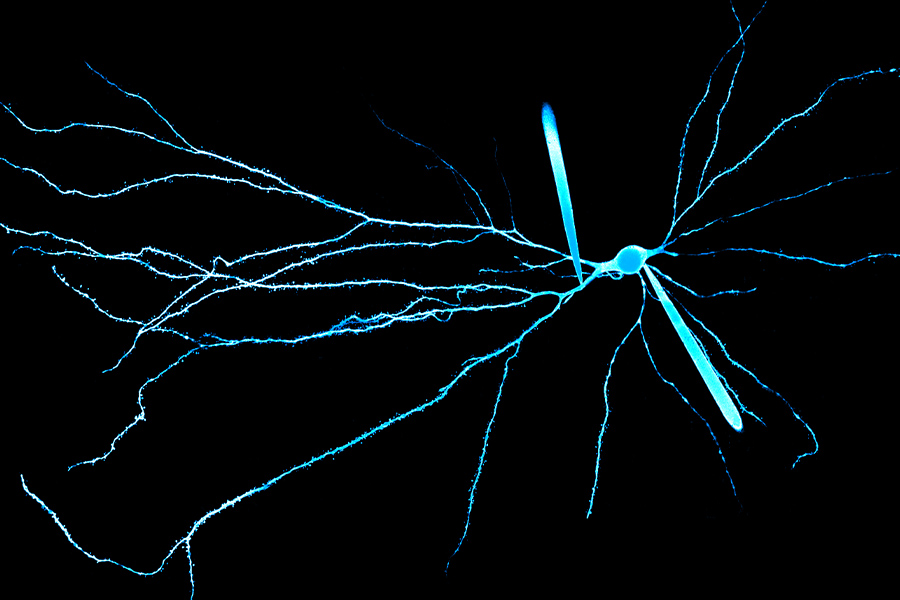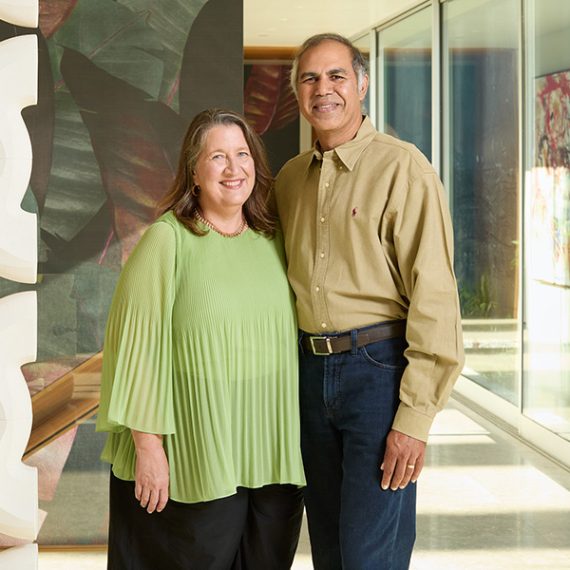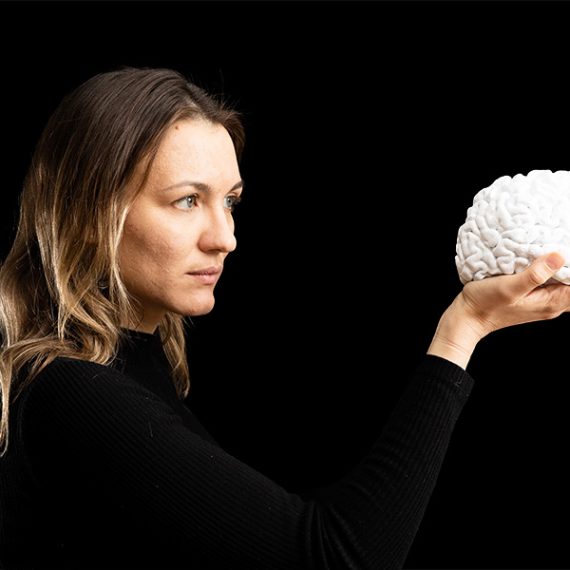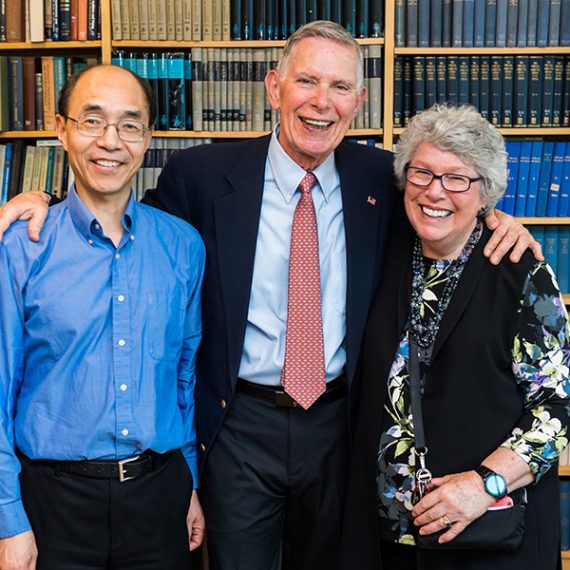Listening to neurons
The Harnett Lab is investigating how the brain’s elemental units give rise to the mind.

When McGovern Investigator Mark Harnett gets a text from his collaborator at Massachusetts General Hospital, it’s time to stock up on Red Bull and coffee.
Because very soon—sometimes within a few hours—a chunk of living human brain will arrive at the lab, marking the start of an epic session recording the brain’s internal dialogue. And it continues non-stop until the neurons die.
“That first time, we went for 54 hours straight,” Harnett says.
Now two years old, his lab is trying to answer fundamental questions about how the brain’s basic calculations lead to the experience of daily life. Most neuroscientists consider the neuron to be the brain’s basic computational unit, but Harnett is focusing on the internal workings of individual neurons, and in particular, the role of dendrites, the elaborate branching structures that are the most distinctive feature of these cells.
Years ago, scientists viewed dendrites as essentially passive structures, receiving neurochemical information that they translated into electrical signals and sent to the cell body, or soma. The soma was the calculator, summing up the data and deciding whether or not to produce an output signal, known as an action potential. Now though, evidence has accumulated showing dendrites to be capable of processing information themselves, leading to a new and more expansive view in which each individual neuron contains multiple computational elements.
Due to the enormous technical challenge such work demands, however, scientists still don’t fully understand the biophysical mechanisms behind dendritic computations.
They understand even less how these mechanisms operate in and contribute to an awake, thinking brain—nor how much the mouse models that have defined the field translate to the vastly more powerful computational abilities of the human brain.
Harnett is in an ideal position to untangle some of these questions, owing to a rare combination of the technology and skills needed to record from dendrites—a feat in itself—as well as access to animals and human tissue, and a lab eager for a challenge.
Human interest
Most previous research on dendrites has been done in rats or mice, and Harnett’s collaboration with MGH addresses a deceptively simple question: are the brain cells of rodents really equivalent to those of humans?
Researchers have generally assumed that they are similar, but no one has studied the question in depth. It is known, however, that human dendrites are longer and more structurally complex, and Harnett suspects that these shape differences may reflect the existence of additional computational mechanisms.
To investigate this question, Harnett reached out to Sydney Cash, a neurologist at MGH and Harvard Medical School. Cash was intrigued. He’d been studying epilepsy patients with electrodes implanted in their brains to locate seizures before brain surgery, and he was seeing odd quirks in his data. The neurons seemed to be more connected than animal data would suggest, but he had no way to investigate. “And so I thought this collaboration would be fantastic,” he says. “The amazing electrophysiology that Mark’s group can do would be able to give us that insight into the behavior of these individual human neurons.”
So Cash arranged for Harnett to receive tissue from the brains of patients undergoing lobe resections—removal of chunks of tissue associated with seizures, which often works for patients for whom other treatments have failed.
Logistics were challenging—how to get a living piece of brain from one side of the Charles River to the other before it dies? Harnett initially wanted to use a drone; the legal department shot down that idea. Then he wanted to preserve the delicate tissue in bubbling oxygenated solution. But carting cylinders of hazardous compressed gas around the city was also a non-starter. “So, on the first one, we said to heck with it, we’ll just see if it works at all,” Harnett says. “We threw the brain into a bottle of ice-cold solution, screwed the top on, and told an Uber driver to go fast.”
When the cargo reaches the lab, the team starts the experiments immediately to collect as much data as possible before the neurons fail. This process involves the kind of arduous work that Harnett’s first graduate student, Lou Beaulieu-Laroche, relishes. Indeed, it’s why the young Quebecois wanted to join Harnett’s lab in the first place. “Every time I get to do this recording, I get so excited I don’t even need to sleep,” he says.
First, Beaulieu-Laroche places the precious tissue into a nutrient solution, carefully slicing it at the correct angle to reveal the neurons of interest. Then he begins patch clamp recordings, placing a tiny glass pipette to the surface of a single neuron in order to record its electrical activity. Most labs patch the larger soma; few can successfully patch the far finer dendrites. Beaulieu-Laroche can record two locations on a single dendrite simultaneously.
“It’s tricky experiment on top of tricky experiment,” Harnett says. “If you don’t succeed at every step, you get nothing out of it.” But do it right, and it’s a human neuron laid bare, whirring calculations visible in real-time.
The lab has collected samples from just seven surgeries so far, but a fascinating picture is emerging. For instance, spikes of activity in some human dendrites don’t seem to show up in the main part of the cell, a peculiar decoupling mice don’t show. What it means is still unclear, but it may be a sign of Harnett’s theorized intermediary computations between the distant dendrites and the cell body.
“It could be that the dendrite network of a human neuron is a little more complicated—maybe a little bit smarter,” Beaulieu-Laroche speculates. “And maybe that contributes to our intelligence.”
Active questioning
The human work is inherently limited to studying cells in a dish, and that gets to Harnett’s real focus. “A huge amount of time and effort has been spent identifying what dendrites are capable of doing in brain slices,” he says. Far less effort has gone into studying what they do in the behaving brain. It’s like exhaustively examining a set of tires on a car without ever testing its performance on the road.
To get at this problem, Harnett studies spatial navigation in mice, a task that requires the mouse brain to combine information about vision, motion, and self-orientation into a holistic experience. Scientists don’t know how this integration happens, but Harnett thinks it is an ideal test bed for exploring how dendritic processes contribute to complex behavioral computations. “We know the different types of information must eventually converge, but we think each type could be processed separately in the dendrites before being combined in the cell body,” he says.
The difficult part is catching neurons in the act of computing. This requires a two-pronged approach combining finegrained dendritic biophysics—like what Beaulieu-Laroche does in human cells— with behavioral studies and imaging in awake mice.
Marie-Sophie van der Goes, Harnett’s second graduate student, took up the challenge when she joined the lab in early 2016. From previous work, she knew spatial integration happened in a structure called the retrosplenial cortex, but the region was not well studied.
“We didn’t know where the information entering the RSC came from, or how it was organized,” she explains.
She and laboratory technician Derrick Barnagian used reverse tracing methods to identify inputs to the RSC, and teamed up with postdoc Mathieu Lafourcade to figure out how that information was organized and processed. Vision, motor and orientation systems are all connected to the region, as expected, but the inputs are segregated, with visual and motor information, for example, arriving at different locations within the dendritic tree. According to the patch clamp data, this is likely to be very important, since different dendrites appear to process information in different ways.
The next step for Van der Goes will be to record from neurons as mice perform a navigation task in a virtual maze. Two other postdocs, Jakob Voigts and Lukas Fischer, have already begun looking at similar questions. Working with mice genetically engineered so that their neurons light up when activated, the researchers implant a small glass window in the skull, directly over the RSC. Peering in with a two-photon microscope, they can watch, in real time, the activity of individual neurons and dendrites, as the animal processes different stimuli, including visual cues, sugar-water reward, and the sensation of its feet running along the ground.
It’s not a perfect system; the mouse’s head has to be held absolutely still for the scope to work. For now, they use a virtual reality maze and treadmill, although thanks to an ingenious rig Voigts invented, the set-up is poised to undergo a key improvement to make it feel more life-like for the mouse, and thus more accurate for the researchers.
Human questions
As much as the lab has accomplished so far, Harnett considers the people his greatest achievement. “Lab culture’s critical, in my opinion,” Harnett says. “How it manifests can really affect who wants to join your particular pirate crew.”
And his lab, he says, “is a wonderful environment and my team is incredibly successful in getting hard things to work.”
Everyone works on each other’s projects, coming in on Friday nights and weekend mornings, while ongoing jokes, lab memes, and shared meals bind the team together. Even Harnett prefers to bring his laptop to the crowded student and postdoc office rather than work in his own spacious quarters. With only three Americans in the lab—including Harnett —the space is rich in languages and friendly jabs. Canadian Beaulieu-Laroche says France-born Lafourcade speaks French like his grandmother; Lafourcade insists he speaks the best French—and the best Spanish. “But the Germans never speak German,” he wonders.
And there’s another uniting factor as well—a passion for asking big questions in life. Perhaps it is because many of the lab members are internationally educated and have studied more philosophy and literature than a typical science student. “Marie randomly dropped a Marcus Aurelius quote on me the other day,” Harnett says. He’d been flabbergasted, “But then I wondered, what is it about the fact that they’ve ended up here and we work together so incredibly well? I think it’s that we all think about this stuff—it gives us a shared humanism in the laboratory.”




